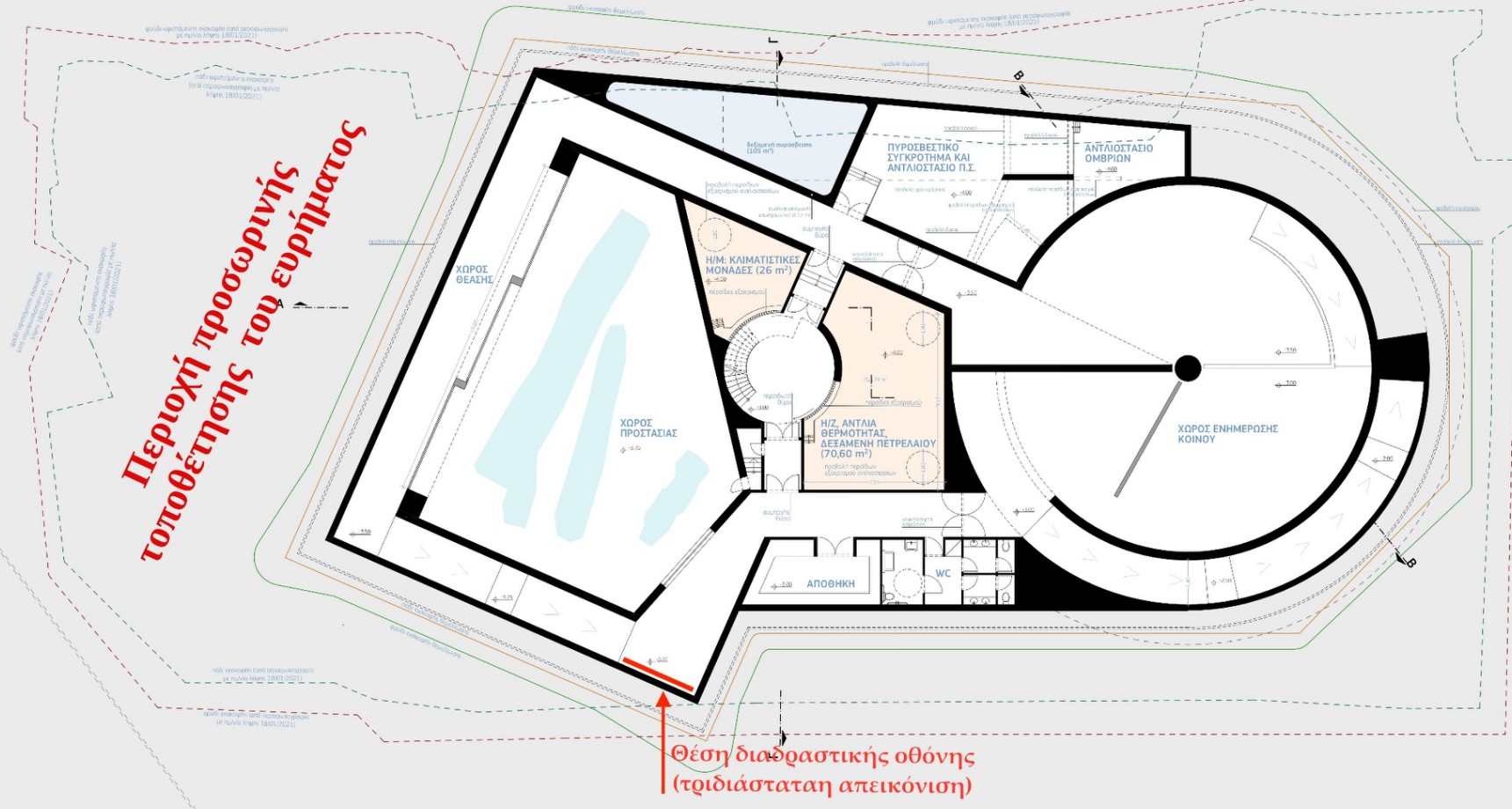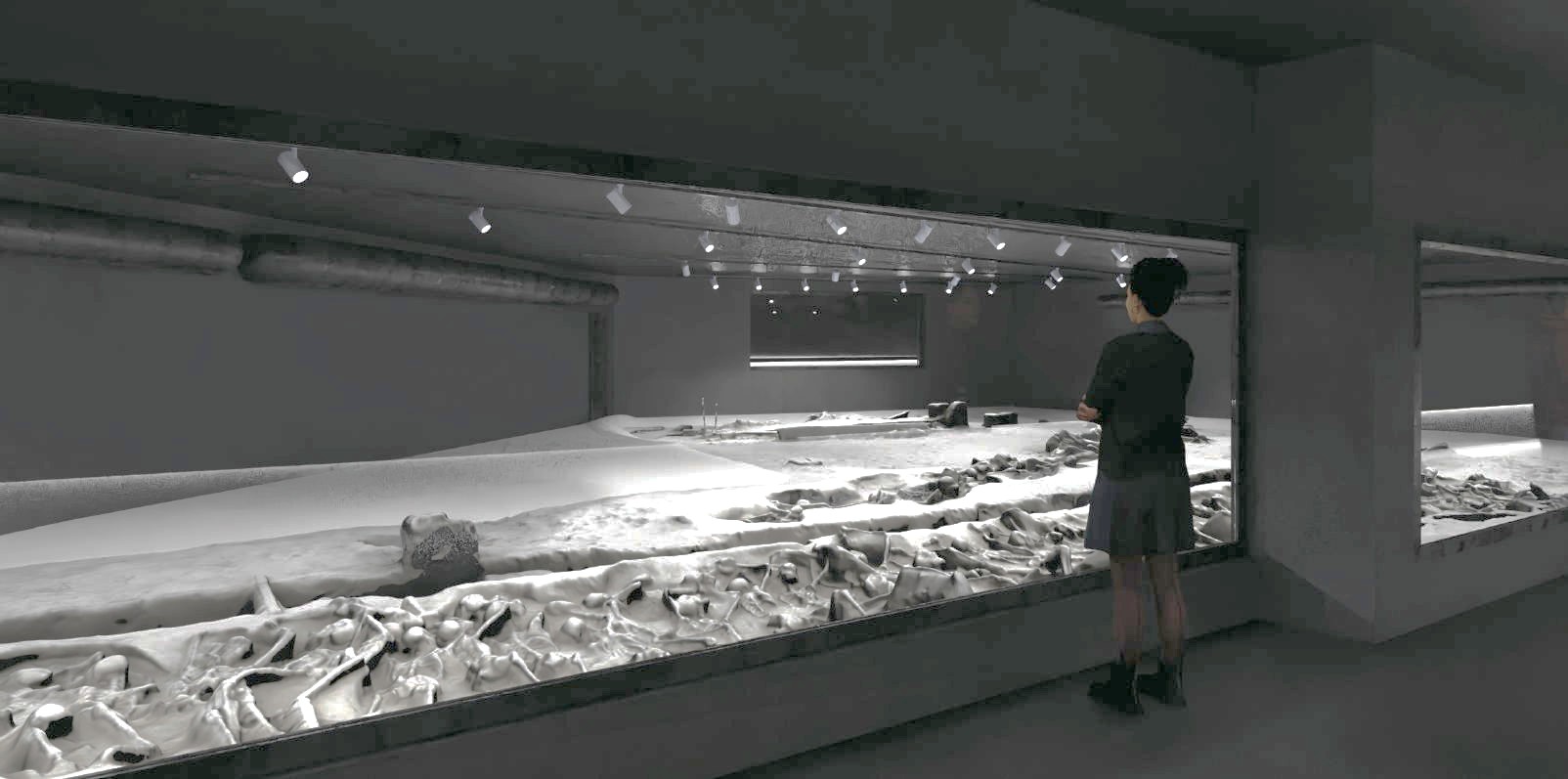Permanent exhibition in the museum shell of the Bound Men of Phaleron. The impressive find is highlighted in situ
- Written by E.Tsiliopoulos
The Ministry of Culture is proceeding with the promotion of the unique find of the "Bound Men", in the Esplanade of Phaleron, next to the Stavros Niarchos Foundation Cultural Center, with the creation of a permanent exhibition, within the museum's protective shell. The project is progressing on schedule, with a budget of 6,500,000 euros, financed by resources from the Recovery Fund. The find dates, according to the excavators, to the turbulent period of the second half of the 7th century BC, constituting a prominent archaeological find of global interest. The aim of the exhibition is to serve the understanding of a unique historical episode, in the turbulent period of the history of Athens, without trapping the visitor's gaze in the violence of the image. Therefore, the find and the place constitute an exceptional unity, where archaeological research meets history.
Minister of Culture Lina Mendoni stated: "The important find of the Bound Men of Phaleron concerns the mass burial of human skeletons which was discovered in March 2016, in the context of the construction of the Stavros Niarchos Foundation Cultural Center. The execution of the "Bound Men", according to the data so far, took place on site. The individuals were buried chained, as the skeletons still bear their metal shackles. From 2016 to 2020, the protection of the find was not adequately ensured, resulting in part of it being lost. In 2020, in order to protect the find in the best possible way, it was decided to temporarily remove it and reposition it in the exact same location, after the soil had been cleaned up. The permanent shell being constructed harmoniously integrates into the landscaped Esplanade, while it is designed as a simple underground shell for the repositioning of the "Bound Men", allowing for optimal viewing and understanding of the find by visitors. The building shell is interconnected with the exhibition, seeking the gradual transition from the present to the past, from light to darkness and the gradual spiritual, cognitive, emotional preparation of the visitor for the "Bindings" exhibit. The conceptual and spatial design of the exhibition is adapted to the specificities of the local preservation, protection and promotion of the monument with a strongly contextual and potentially emotional environment. Focusing also on understanding the socio-political context, the visitor understands the relationship of the events with the genesis of the Athenian Republic. The entire museum infrastructure was designed to be universally accessible.

The museological and museographic approach examines the archaeological site as a historical place, focusing on a unique find linked to an important historical event. The local exhibition of the find is a rare case in Greece. The basic principle is to attribute the historical significance of the find with respect for the dead. The building under construction to promote the antiquities covers approximately 920 sq.m., and has a distinct identity and a simple form. Visitors are led downwards towards the semi-open cylindrical space that starts at ground level and gradually sinks. The architectural design of the building shell aims to create a space that invites the visitor to be informed about the excavation findings, but also to prepare for the correct reading of the mass burial preserved in situ, through the gradual discovery of information, but also by understanding the atmosphere of the space. In the underground space, the skeletal remains - at a level of -3.75 m., will be visible from two areas, through large glass-enclosed openings. The area of the skeletons is not open to the public, requiring controlled conditions for their protection.

In terms of narrative flow, the following thematic units are developed during the visit:
1. Access/entry: Information on the “sensitive” issue of human remains and violent deaths. At this point, the visitor can decide whether to continue their visit. The goal is a conscious choice of visit and not a random entry.
2. Descent/time: The downward path, via the ramp, symbolizes the descent in time. The visitor leaves behind the 21st century and the SNFCC and passes into the ancient world.
3. Transition to the space (Faliro): The visitor understands the spatial planning (Faliro Bay, sea, salt flat, cemetery) and the relationship of Faliro with Athens (four kilometers from the Acropolis, then an hour’s drive). A suggestive comparison is made with today's spatial planning, as the ancient topography has been completely altered.
4. (Circum)transit in the space (cemetery): The visitor explores the different burial practices and customs, values and rites of passage towards the unknown.
5. Transition from institution to law: On The aim is to understand the excavation data and the historical context, as well as to interpret the findings in relation to the history of Athens in the 7th century BC and the political developments that led, in the long term, to the birth of democracy.
6. Stop/on-site viewing: Moving in a straight line, the visitor reaches the exhibition area of the remains of the “Desmots”. In contrast to the previous sections, the central point of the visit is a space of silence.
7. Representation/pause: The historical moment that was “frozen in time” is transformed into movement through the therapeutic power of art.
8. Ascent/exit: The visitor follows the reverse -ascending- course in space and time.
Accompanying visual material offers information and interpretive directions, utilizing a multitude of interpretive media, mainly conventional, but also digital, such as texts, photographs, drawings, maps, representations, graphics, and interactivity.

History of excavations, discovery, and management of finds
The Faliraki Bay, the first port of ancient Athens, hosted the largest known cemetery of the city, in use from the 8th to the 4th century BC. Out of an area of 70 acres, 11 acres have been investigated, revealing 1920 burials, with 2087 people. Most date back to the Archaic period. The large number and, above all, the variety of Phaleric burials and burial practices (ordinary and "deviant" burials, where not all burial customs were performed, primary and secondary cremations, animal burials, etc.), primarily illustrate the living conditions of all economic classes of Athenian society. They reflect the social behavior of its members towards the dead, forming an extremely representative and not idealized image of it. It is the only cemetery, throughout its use, in Attica, with numerous individual or group burials of violent deaths (fractures and amputations, iron shackles, unusual burial positions) a fact that makes it a possible burial site of those sentenced to death, in the archaic and classical years. Approximately 10.7% of the buried, or 229 individuals, belong to this category.
The first investigations began in 1863 and were followed by rescue excavations in 1911 and 1915, where the large area and duration of the cemetery were recognized. An important find was the “Ironworker’s Grave” with 18 executed persons, which documented the manner of execution of the condemned by bludgeoning. In 1923–1925, the bibliographic documentation and the protection of the site enhanced its importance. In 1925, the creation of the hippodrome and the declaration of the area around it as public, prohibiting the construction of buildings, contributed to the protection of the antiquities.
The new period of excavations (2009-2016) began with the construction of the Stavros Niarchos Foundation Cultural Center (SNFCC) on the site of the old hippodrome, bringing to light the impressive find of the 79 “Bounds” on the Esplanade. Iron-bound men were laid in 3 rows, some tied back to back and others tied together, receiving a fatal blow to the head. Their execution is associated with the period of political unrest that began in the early 7th century BC and lasted until the 6th century BC.
In 2016, it was decided to preserve and display the findings in situ and to construct a protective shell. In 2020, as significant problems were identified in the state of conservation of the find, the temporary and conditional removal and re-installation of the find was approved, due to the deteriorating state of conservation and deterioration of the remains, due to the particular geological background. From 2020-2023, the required studies were approved for the construction of the permanent protection and display area of polyandry antiquities, in the Esplanade. The construction of the museum shell will be completed in 2026 by the services of the Ministry of Culture.
Related items
-
 REIMAGINE TOURISM 2025: Greek success story in tourism a reference point for many countries, according to UN Tourism Secretary-General
REIMAGINE TOURISM 2025: Greek success story in tourism a reference point for many countries, according to UN Tourism Secretary-General
-
 2nd Greek Youth Diaspora Symposium, entitled “Diaspora Dialogues: Connecting Young Voices around the world” (Athens, 25-28.11.2025)
2nd Greek Youth Diaspora Symposium, entitled “Diaspora Dialogues: Connecting Young Voices around the world” (Athens, 25-28.11.2025)
-
 Yiannis Galatsanos (Diffraqtion): The Greek founder who swept the Slush 100 and raises millions from the US and Europe
Yiannis Galatsanos (Diffraqtion): The Greek founder who swept the Slush 100 and raises millions from the US and Europe
-
 Antiquities smuggling ring: Professor caught with a large number of antiquities and his collaboration with a Bulgarian tycoon
Antiquities smuggling ring: Professor caught with a large number of antiquities and his collaboration with a Bulgarian tycoon
-
 Actress Matsouka and Tennis star Tsitsipas in legal heat over traffic misdeeds
Actress Matsouka and Tennis star Tsitsipas in legal heat over traffic misdeeds
Latest from E.Tsiliopoulos
- REIMAGINE TOURISM 2025: Greek success story in tourism a reference point for many countries, according to UN Tourism Secretary-General
- 2nd Greek Youth Diaspora Symposium, entitled “Diaspora Dialogues: Connecting Young Voices around the world” (Athens, 25-28.11.2025)
- Yiannis Galatsanos (Diffraqtion): The Greek founder who swept the Slush 100 and raises millions from the US and Europe
- Antiquities smuggling ring: Professor caught with a large number of antiquities and his collaboration with a Bulgarian tycoon
- Actress Matsouka and Tennis star Tsitsipas in legal heat over traffic misdeeds


